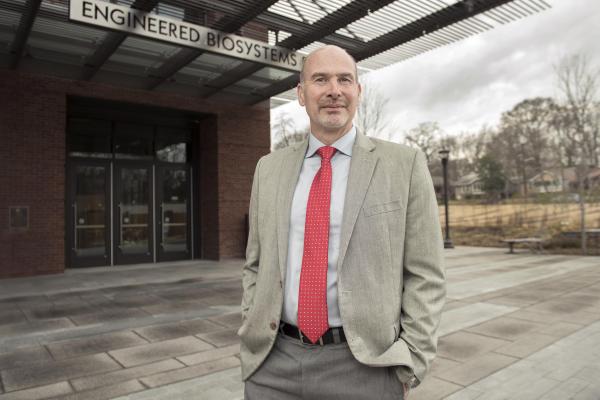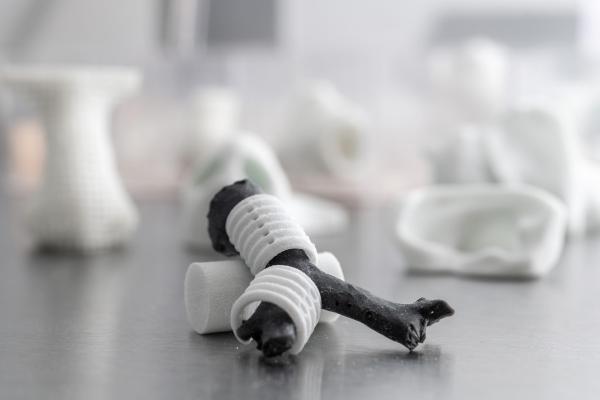In February 2012 Kaiba Gionfriddo, just three-months old, had already run out of options to treat his tracheobronchomalacia, a birth defect that was causing his airways to collapse. So his parents took him to the University of Michigan Medical Center, where Scott Hollister and Glenn Green were working on a life-saving solution.
Hollister (who at the time was associate professor of oral surgery and a professor of biomedical engineering) and Green (associate professor of pediatric otolaryngology) had spent the previous year working on their idea, a 3D-printed, patient specific airway splint that was bioresorbable.
They captured images of Kaiba’s trachea with a CT scan and, using a 3D printer, constructed a splint tailored to fit Kaiba. The tiny tube (actually, about three-quarters of a tube, as the device is designed to slip around the trachea) was attached to the surface of Kaiba’s airway, creating a kind of exoskeleton that actually pulls the trachea open. The effects were instantaneous as Kaiba’s lungs began to inflate and deflate normally.
This was a groundbreaking medical breakthrough that made national headlines. The new device gave hope to families with children who have the most relentless cases of tracheobronchomalacia, a condition that occurs once in 2,200 births (or about 1,500 to 1,800 babies a year), ranging in severity.
A lot has happened since Kaiba’s case. For one thing, 21 patients have now received the device. For another, Hollister has become a professor in the Wallace H. Coulter Department of Biomedical Engineering at Georgia Tech and Emory University, and a researcher in the Petit Institute for Bioengineering and Bioscience at Tech. Kaiba, now seven, is doing well and is the oldest patient among 15 children who are part of a recently published study from Hollister and his colleagues in the journal The Laryngoscope.
“This paper really establishes how the device performs clinically, and the long term outcomes,” says Hollister. “So this study was focused more on the quality of life after the procedure.”
Last year, three custom-printed tracheal splints, developed by Hollister’s lab at Georgia Tech, were placed in a seven-month-old patient at Children’s Healthcare of Atlanta, the first such procedure in Georgia. Hollister says he and his Atlanta team will continue moving their program forward with the hopes of running a clinical trial with Children’s.
That first Georgia patient was not part of the most recently published study, but as with the other babies who have received the device, the procedure was allowed to happen the physicians received emergency clearance from the U.S. Food and Drug Administration (FDA).
For their study, the researchers looked at the clinical safety and efficacy of the device, focusing on 15 patients (ranging in age from three to 25 months) who had received 29 splints on their trachea from 2012 to 2018. They took into account a patient’s history of extracorporeal membrane oxygenation (ECMO), and other circumstances. For instance, 13 of the patients had been chronically hospitalized, and seven their entire lives.
The researchers collected outcome information on respiratory support that may have been needed post-procedure, disposition, and splint-related complications and concluded that all surviving patients experienced significant improvement.
“FDA has been extremely helpful and supportive through this process,” says Hollister. “We really hope our data will now support a clinical trial. That would be the next step, FDA approval and a broader application.”
The device would be considered under humanitarian device exemption rules (applied in devices designed to treat diseases that affects fewer than 8,000 patients a year), and that would require only a Phase One trial, Hollister says, “to prove that it’s safe.”
In addition to Hollister and Green (corresponding authors), the other researchers, all from the University of Michigan, include Andrea Les, Richard Ohye, Amy Filbrun, Maryam Ghadimi, Colleen Flanagan, Rodney Daniels, Kelly Kidwell, and David Zopf.
Media Contact
Jerry Grillo
Communications Officer II
Parker H. Petit Institute for
Bioengineering and Bioscience
Keywords
Latest BME News
Jo honored for his impact on science and mentorship
The department rises to the top in biomedical engineering programs for undergraduate education.
Commercialization program in Coulter BME announces project teams who will receive support to get their research to market.
Courses in the Wallace H. Coulter Department of Biomedical Engineering are being reformatted to incorporate AI and machine learning so students are prepared for a data-driven biotech sector.
Influenced by her mother's journey in engineering, Sriya Surapaneni hopes to inspire other young women in the field.
Coulter BME Professor Earns Tenure, Eyes Future of Innovation in Health and Medicine
The grant will fund the development of cutting-edge technology that could detect colorectal cancer through a simple breath test
The surgical support device landed Coulter BME its 4th consecutive win for the College of Engineering competition.









